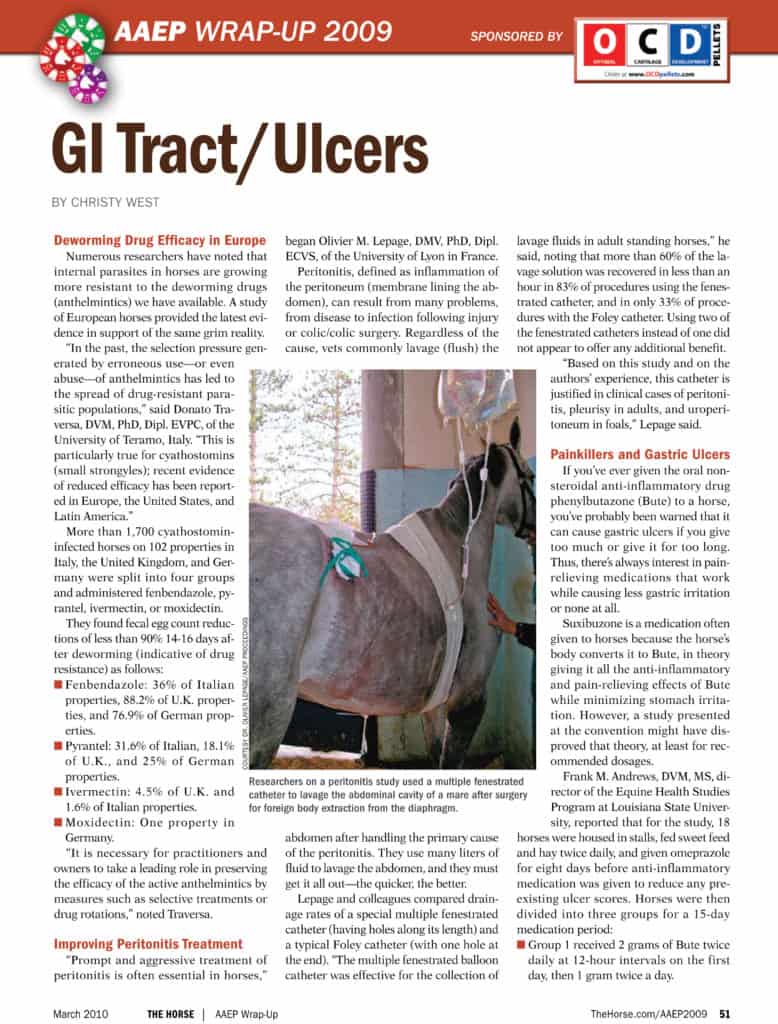High Risk Pregnancy in the Mare Discussed at Vet Convention
The High Risk Pregnancy in the Mare session at the 2009 AAEP Conference was very well attended.
The High Risk Pregnancy in the Mare session at the 2009 AAEP Conference was very well attended.
Because navicular problems might affect soft tissue as well as bone, MRI is a better diagnostic tool than X ray in these cases, said Robert K. Schneider, DVM, MS, professor at Washington State University College of Veterinary Medicine, and part
More than 260 research scientists, veterinarians, and physicians from around the globe attended the first North American Veterinary Regenerative Medicine Conference, held in California’s Santa Ynez Valley March 5-6. The meeting included for
There is no “one-size-fits-all” non-steroidal anti-inflammatory drug (NSAID) therapy for horses; therapy should be tailored to the animal and situation, said Cornell University’s Thomas J. Divers, DVM, Dipl. ACVIM, ACVECC, at the

For more than 150 years veterinarians have been performing prepurchase exams, also referred to as vetting, purchase exams, and soundness exams. Two veterinarians discussed purchase exams in general and specifically for Western performance horses at the 2009 American Association of Equine Practitioners Convention.

Researchers discussed respiratory topics in horses including influenza outbreaks and vaccination boosters, furosemide for exercise-induced pulmonary hemorrhage, dorsal displacement of the soft palate, dynamic respiratory tract endoscopy (during exercise), and more at the 2009 convention of the American Association of Equine Practitioners.

Deworming medication resistance, persimmon risks, peritonitis treatment advances, Salmonella biosecurity guidelines, and more equine gastrointestinal topics were discussed at the 2009 convention of the American Association of Equine Practitioners.
Horses with the hereditary skin disease known as hereditary equine regional dermal asthenia (HERDA) or hyperelastosis cutis (HC) have been recognized since the 1970s, but only recently have researchers defined just how much weaker their skin is

Miscellaneous sessions at the 2009 AAEP Convention, including skin characteristics of horses affected with hereditary regional dermal asthenia (HERDA, effects of Lawsonia infection on performance, unwanted horses survey, castration complications and more.
“There’s a large part of the world that depends more than ever on working equids,” said Jay Merriam, DVM, of Massachusetts Equine Clinic, in Uxbridge, who moderated the first-ever AAEP convention session on equitarian initiatives (2009). Merriam defined an equitarian as “one who serves equids with compassion, and whose only reward is their improved health and welfare.”

The hottest news in equine veterinary medicine in 2009 included a lethal medication compounding error, genetic deafness in Paint horses, bacteremia in foals, piroplasmosis, exercise-induced pulmonary hemorrhage, and more. (Presented at the Kester News Hour session, American Association of Equine Practitioners Convention, 2009)

Several topics related to lameness in horses were presented at the 2009 American Association of Equine Practitioners convention, from racehorse lameness to regional limb perfusion, nerve blocks, and radiographic findings in Quarter Horses.

Treatments for lameness in horses, including tenotomy surgery for laminitis, arthritis treatments, stem cells, maggots for wound therapy, electrotherapy, manual therapies, and more were discussed at the 2009 convention of the American Association of Equine Practitioners.

There have been marked changes in the level of equine critical care, noted Fairfield Bain, DVM, MBA, Dipl. ACVIM, ACVP, ACVECC, during the 2009 convention of the American Association of Equine Practitioners. These changes, he said, are in large part due to improved skills, training, and experience of practitioners that facilitate expeditious case assessment.
Although antibiotic resistance is not as serious a problem for horses as it is for people, the equine industry should use antibiotics judiciously, so they will continue to work against bacteria that cause disease – not just for the benefit of h
Learn about the normal functions of bones, cartilage, soft tissues, and fluids within the fetlock joint.
Stay on top of the most recent Horse Health news with
"*" indicates required fields